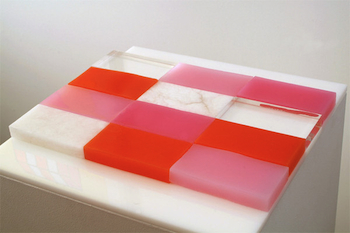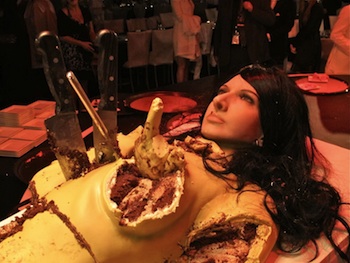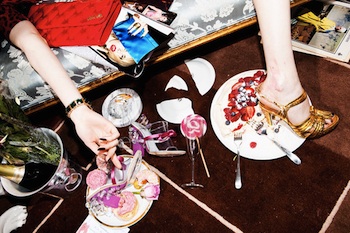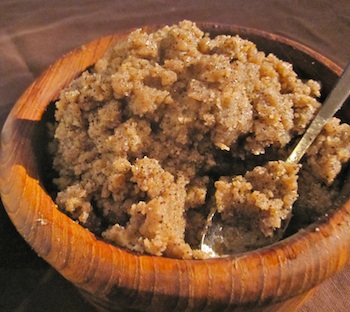At the end of 2009, I looked back on the year through meat, recognizing a proliferation of protein in contemporary art and popular culture. In 2010, with the help of two food-savvy art writers, we surveyed the world of food art and produced an epic post. And now I bring you a year-end roundup all about sweets. Here’s ten projects that caught my eye in 2011:
Monica Martinez of Don Bugito
Headlands Center for the Arts, Sausalito, CA
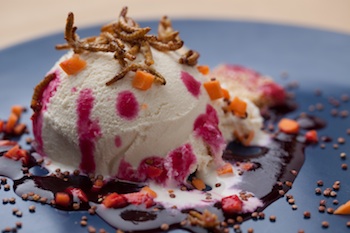
Monica Martinez of Don Bugito. Mealworm toffee with vanilla ice cream with amaranth and cactus syrup, 2011. Courtesy the artist. Photo: Michelle Edmunds.
When you picture yourself eating a big scoop of ice cream you probably don’t think about worms as a topping. Who does? Bay Area artist Monica Martinez. Her new food venture Don Bugito grew out of earlier works concerning informal food economies like street food carts in her native Mexico City, and her ongoing interest in edible bugs. This year, Martinez partnered with Critter founder Philip Ross, and Mezcal Factoria de Santos to prepare a dinner of Edible Insects & Other Rare Delicacies at Headlands Center for the Arts. Guests were served, among other things, wax moth larvae corn custard, and mealworm toffee over vanilla ice cream with amaranth and cactus syrup. How have people responded to Martinez’s “mini livestock” gourmet? “Amazingly,” she says. With an incubator kitchen already backing the artist, Don Bugito is poised to become a long-term fixture in the Bay Area food scene.
Naomi Huth of Where Am I
Prospect Heights, Brooklyn, NY
Naomi Huth — curator, artist, and founder of the roving gallery Where Am I — has turned a row of empty Brooklyn storefronts into an urban sweetscape. Cakes painted on old cookbook pages, Polaroids of candy-adorned bodies, and jell-o-ee video performance are the goodies of Huth’s exhibition Food Lust: Shock Candy. A personal favorite of mine is Desert Jell-O Grid by Claire Lieberman. (Yes, that’s desert not dessert.) Lieberman’s manipulation and juxtaposition of firm and flexible materials like marble and Jell-O reveal their similarities perhaps more than their differences. Food Lust comes “just in time to offer an interesting contrast to the regular holiday displays.” The exhibition is on view at the corner of Classon and Lincoln (map) through January 3.
Victoria Yee Howe
Arabica Lounge, Seattle, WA
Artist and pastry chef Victoria Yee Howe, who has been featured on this blog before, continues to push the boundaries of frosted art. This year, she participated in the first ever food + art residency at Seattle’s Arabica Lounge. Twice a week for eight weeks she has created the Lounge’s dessert specials, some of them more “avant-garde” than others. For instance, her series of Bruise Cakes. Made from a strawberry-purée batter (a southern classic known as “Pink Lady”) and layered with fresh blueberry preserves, these cakes sound heavenly until Howe explains the inspiration for their title and coloring: each is topped with a photo-transfer of different bruises that past lovers have left on her body. “I have always taken photos of different cuts or scrapes I have had, accidental or consensual or whatever,” says Howe. “…I love the idea of playing with people’s conceptions of what is desirable and edible and maybe even making them a little uncomfortable with their hunger.”
Peter Nadin
Gavin Brown’s Enterprise, New York, NY

Peter Nadin. "Raft," 2011. Honey, terracotta, wood, twine, bank run, wax and ham, 288 x 288 x 9 1/2 in.
Honey was medium and merchandise in First Mark, this year’s highly praised solo exhibition of works by artist-farmer Peter Nadin. (Writer Andrew Russeth, who contributed to our food art survey last year, beautifully captured the show for his blog 16 Miles of String.) Nadin’s honeyed objects included Raft, a rather monumental pond of the sticky substance, with terracotta, wood, ham, and other materials rising from its surface. Any cravings this work might have inspired could be satisfied in a pop-up shop of sorts, a buying club temporarily hosted by the gallery that offered honey and maple syrup produced on Nadin’s farm. The artist himself is fully immersed in the stuff of bees and honey: In 2006, he was a delegate at the South American Beekeepers’ Conference.
Marina Abramović
Kreemart and the Museum of Contemporary Art, Los Angeles, CA
Abramović’s plans for MOCA’s Annual Gala were met with controversy weeks before the event took place. (Art21 blogger Catherine Wagley covers this at length in her latest post.) If you thought her use of people as dinner table centerpieces was disturbing, dessert wasn’t far removed. Teamed up again with the art and dessert group Kreemart, Abramović presented guests with two cakes: a chocolate one made in her likeness and another in red velvet that resembled Blondie front woman Debbie Harry. Needless to say, the normally joyous act of cutting cake looked extremely creepy.
Jessica Craig-Martin
20 x 200, Online
Although sweets are not the focal point of Craig-Martin’s photograph Let’s Party, the swirled lollipop, pink-frosted pastries, and berries underfoot add a nice touch of abandon to this stylish scene, appearing as if it has been ripped from the pages of a fashion magazine. Let’s Party is one of two gorgeous prints by Martin currently on offer from the affordable art shop 20 x 200. In fact, 20 x 200 has quite a few delicious-looking images in their “food” category, with prints starting at just half the cost of a Momofuku Crack Pie. Art lasts longer.
Caitlin Williams Freeman and Leah Rosenberg of Blue Bottle Coffee Company
San Francisco Museum of Modern Art, San Francisco, CA
Ever since partnering with Blue Bottle Coffee company, SF MOMA has been a leader in food art. Their Rooftop Café continuously offers creative desserts based on works in the museum’s galleries. This year, Blue Bottle’s Caitlin Williams Freeman and Leah Rosenberg created a popsicle inspired by John Zurier’s painting Arabella (2005), on view in The More Things Change exhibition. (Zurier is on faculty at the local California College of the Arts.) Spearmint ice milk and fresh strawberry ice cream must complement each other as much in flavor as they do in color.
Michael Pribich
Project Row Houses, Houston, TX
Cut sugar cane was the centerpiece of Michael Pribich’s spring installation for Project Row Houses, where food was the focus of their spring exhibition. Pribich, unlike other artists highlighted in this post, calls attention to sugar’s darker side. Bags of Imperial Sugar stacked upon wall-mounted machetes made reference to current labor practices in the Caribbean, where Pribich first witnessed cane harvesting. In the Dominican Republic, “Haitian field workers were hand-harvesting ‘cana’ with machetes,” he writes. “Oxen teams pulled wooden carts laden with cut sugar cane. The fields stretched for miles and miles with laborers scattered along the horizon. A pastoral, Bruegel scene it was not … sugar is not so simple.”
Janine Antoni for Creative Time
Park Avenue Summer, New York, NY
Inspired by the idea that you shouldn’t use anything on your skin that you wouldn’t put in your mouth, Art21 artist Janine Antoni presented In & On, an edible art project at the New York City restaurant Park Avenue Summer. Working with executive chef Kevin Lasko and the organic skin care company Fat and the Moon, Antoni developed three seasonal dishes, each with its own nourishing skincare product. “Scales and Skin,” a coffee-cured Hamachi and ginger pickled black plum appetizer was accompanied by a sugar salt scrub made of coconut, coffee, coconut oil, brown sugar, and sea salt that guests could try at their table or take to-go.
Joël Penkman
Editions Limited, Liverpool, UK
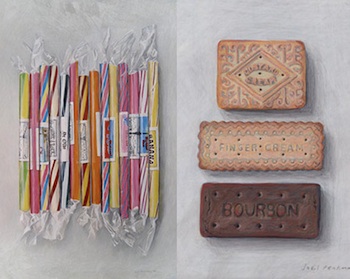
Joël Penkman. "Blackpool Rock," (left) "Cream Biscuits" (right), both from the British Sweets Collection, ongoing.
Martin Parr’s British Food series meets Wayne Thiebaud’s pastries in Joël Penkman’s paintings. Her images of sweets particular to Britain have popped up all over the blogosphere this year, garnering praise for the delight and nostalgia they inspire. In the spring, Limited Editions in Liverpool presented Penkman’s work in a solo exhibition aptly titled Confectionary. What prompted this sweet collection of still lifes? Penkman’s simple love of food and painting: “Combining the two seemed like a good idea.”

